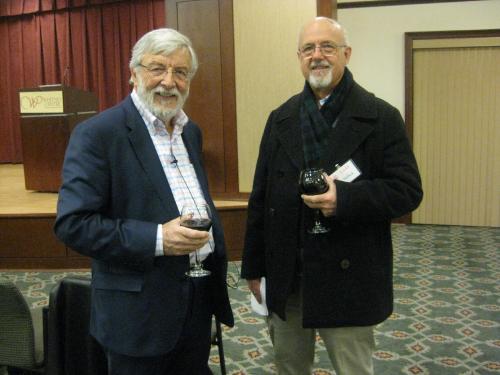Meeting Minutes 1462 December 11, 2017
Connecticut Academy of Arts and Sciences
Whitney Center, Hamden CT
Minutes of CAAS Meeting 1462: “Biomedical Research: Increasing Value, Reducing Waste”” was presented by Dr. Michael Bracken, the Susan Dwight Bliss Professor Emeritus of Epidemiology, Professor Emeritus of Obstetrics and Gynecology, Reproductive Science and Neurology, a former Head of Chronic Disease Epidemiology at Yale University
 The meeting began with a piano concert by Paul J Klein.
The meeting began with a piano concert by Paul J Klein.
Sinfonia in g-minor, BWV 797 – Bach
Andante (d-minor), BWV 971 – Bach
(from the Italian Concerto)
Bagatelle in A-Major (Andante), Op.119/4 – Beethoven
Andante (G-Major), K.545/ll – Mozart
(from Sonata in C-Major)
Prelude in D-Major, Op,11/5 – Scriabin
Two Pieces from Six Christmas Pieces, Op.72 – Mendelssohn
Allegro non troppo (G-Major), Op.72/1
Andante sostenuto (E-flat Major), Op.72/2
Two Waltzes from Op.39 – Brahms
Waltz in g#-minor, Op.39/3
Waltz in A-flat Major, Op.39/15
Aria in G-Major, BWV 988 – Bach
(from the Goldberg Variations)
Played as a cycle.

The President of CAAS thanked our CAAS member, Paul J. Klein, for a terrific short piano concert that was uniquely appropriate for our December meeting. By way of background, he pointed out that Mr. Klein is a graduate of Brown University and the Yale University School of Music. The audience responded with prolonged ovation.
Professor Tignor then introduced two new members of the Academy, Professors Emeriti, Mary Helen and Timothy Goldsmith. Their appointments were enthusiastically approved by voice vote of the membership.
[PHOTO: Left, Professor Bracken; Right, Professor Holford, former treasurer of CAAS]
Following this vote, the President introduced Professor Bracken not only as a distinguished scholar but also as a longtime and often helpful colleague.
Professor Bracken introduced his talk by describing three experimental designs including: Experimental Studies; Observational Studies; and Meta-Analysis (Secondary Analysis) of multiple studies. He mentioned some sources of research inefficiency that were not the focus of his talk today. By way of example, he pointed out that 200 hours of ethics approval was used for study of risk factors for subarachnoid.
He then showed a NT Times study that estimated that scientific fraud affects up to 2% of research. He quoted Michael Rosner, Executive Editor of J Cell Biology: “25% of all accepted manuscripts have had one or more illustrations that were manipulated in ways that violate the journal’s guidelines.”
Bracken showed evidence that supported the concept that: “There is a loss of editorial control in scientific publishing, no peer review – anything can be published.” Using quotes from Lancet and JAMA editors, he pointed out the billions of dollars are potentially wasted.
Bracken then set about to explain how to increase value and reduce waste. He saw two warning signs: “Failure to publish and biased publication.” He gave numerous examples of both. Professor Bracken also cited unnecessary and redundant publication as contributing to unnecessary waste.
He then turned to the human tragedy involved when epidemiologic research is not evaluated cumulatively as happened with sudden infant death syndrome where deaths occurred unnecessarily.
He then pointed out the joint dangers presented by invalid research and the failure to replicate.
Bracken raised solutions in design, conduct and analysis for reducing waste and improving efficiency.
He offered several ways of reducing bias by systematically updating all evidence after study completion.
DISCUSSION
Question: In randomized, double-blind studies. How about using cross-over.
Answer: Can’t do that for many conditions. Trying a 3-way trial at Yale right now.
Question: Your data are attractive. What is the role of academic pressure to publish thereby producing fraud? What about the role of institutional review boards who lack experience?
Answer: Boards waste a lot of time. Less focus on whether it is an important.
Question: We treat individuals, not populations. Many differences and statistics are washing out differences. Meta-analysis is also washings out differences. Diagnoses have changed. Can’t examine changes in diagnosis during studies.
Answer: Let me push back on one item. Have to do research to know about differences to learn about the problems you’ve cited.
Question: I’m not from medical field but same problems come from humanities. Research in legal areas has similar problems. What are remedies?
Answer: People doing research of journals have found that some results are bogus. Are results reported legitimate? So much is economics where hotels are seeking business by booking various conferences.
Question: What are implications for non-academic practice of medicine?
Answer: There are commissions trying to provide useful information. Can’t practice medicine unless based on latest reports. Exactly what commissions are trying to do, provide useful information?
Question: What about those with vested interest with those doing research? Maybe “big pharma.” Profit motive
Answer: People doing research on journals have found people make bogus reports. Hard nut to crack. Really hard to crack this. “Pharma” has better reputation than others.
Question: Last week’s talk at CAAS is not being reported in medical journals because of a lack of interest. This was a published error. You’ve brought attention to a big problem.
Answer: Yes
Question: Getting papers published for a price? What about individuals in studies who are called outliers in research? What are about overhead costs that determine nature of research grants?
Answer: I eliminated one study in today’s talk that examined just this point. There is a problem surrounding grant requests.
Question: Problem with falsified research to push one drug over another.
Answer: I’m not familiar with that particular research.
MINUTES AND PHOTOS BY Gregory Tignor and Monica Aspianto